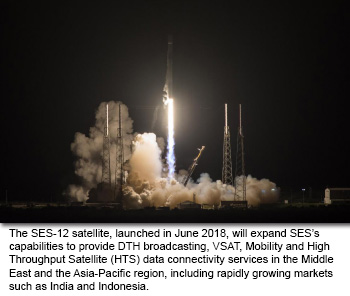2018 Asia-Pacific Satellite Market Update
by Peter I. Galace, Associate Editor
Manila, Philippines, December 5, 2018--Fueled by a surge in global satellite transponder demand that is expected to reach US$ 28.65 billion by 2026, the Asia Pacific satellite industry, propped up by a projected 5.6% regional economic growth in 2018 and 2019, continues to be on the roll. Today, there is a rush for High Throughput Satellite (HTS) with the opening of new opportunities and capabilities in numerous vertical markets across the region to fulfil the growing connectivity demands well into the future.
 The mobility and maritime markets’ need for data to be delivered everywhere with ‘Communications on the Move (COTM)’ is becoming increasingly seen as the key. Commercial airlines in Asia are adopting new in-flight connectivity (IFC) solutions to enable passengers to utilize Wi-Fi and entertainment services while in the air. The massive throughput of HTS spot beams are also providing attractive options for delivering enterprise network and consumer broadband applications that require data-heavy usage within a small vicinity. This is true for oil exploration or mining operations taking place in remote parts of Asia with no terrestrial infrastructure.
The mobility and maritime markets’ need for data to be delivered everywhere with ‘Communications on the Move (COTM)’ is becoming increasingly seen as the key. Commercial airlines in Asia are adopting new in-flight connectivity (IFC) solutions to enable passengers to utilize Wi-Fi and entertainment services while in the air. The massive throughput of HTS spot beams are also providing attractive options for delivering enterprise network and consumer broadband applications that require data-heavy usage within a small vicinity. This is true for oil exploration or mining operations taking place in remote parts of Asia with no terrestrial infrastructure.
Asia’s vast land mass, which includes many rural in isolated areas, means terrestrial broadband is not always an option when deploying high-speed services. This makes HTS ideal for service providers looking to offer competitive broadband packages. Furthermore, HTS’ wide beam feature allows service providers to deliver connectivity to a specific area or location, enabling them to tailor their data services – proving increasingly beneficial for Asia’s aviation and maritime markets.
In broadcasting, HTS has also enabled operators to cope with the competition from terrestrial networks on the ‘cost per bit’ race, by supplying large communication capacity, observes a satellite provider in the region.
HTS Demand Surges
NSR expects total GEO-HTS demand in APAC to exceed 1 Tbps by 2026, with the majority of demand being driven by enterprise data (of which the largest component is cellular backhaul) and consumer broadband. Despite capacity being sold at a significantly lower price point due to more purchases in bulk, NSR sees total APAC GEO-HTS revenues rising to nearly US$ 4 billion annually by 2026, with broadband access and enterprise data representing around US$ 1.5 billion each.
NSR says that as more HTS capacity is launched over APAC, the region’s upper-middle class is expected to provide a significant opportunity for consumer broadband services.
Driven by in-flight connectivity, commercial mobility the market is expected to grow to ~$600M in annual revenues by 2026. A recent forecast by Boeing for airplane demand in the Chinese market indicated that airplane demand expectations have increased over the past year, and the expectation remains that air travel in APAC will continue to flourish over the coming decade. Despite regulatory hurdles to be overcome in some markets (India, China), it is seen as a matter of when, rather than if, the IFC market sees an explosion in demand in APAC. In particular, commercial mobility/IFC are not expected to be as addressable by the above-mentioned national satellite programs, due to the fact that these satellites tend to be country-focused or at best, regional-focused, whereas mobility demands tend to be more global, or at least multi-regional in nature.
APAC Tops Digital Pay TV market
In a region that has primarily been dominated by traditional TV, over-the-top (OTT) video continues to gain traction and has been a major catalyst for HTS demand. According to Media Partners Asia, the APAC online video industry is set to double its share of video industry revenues from 9% in 2017 to 20% by 2023. Furthermore, according to IHS Markit, in Asia Pacific there were three new OTT subscriptions for every new pay TV subscription in 2017 alone.
The Asia Pacific pay TV sector is due to grow its subscriber numbers by 12.8% between 2017 and 2023, bucking downward trends in much of the rest of the world, according to Digital TV Research. The Asia Pacific Pay TV Forecasts report claims that the number of pay TV subscribers across Asia Pacific will climb from 608.7 million in 2017 to 686.4 million in 2023. This marks an increase of some 77.7 million subscribers, with China and India remaining the top one and two countries respectively in 2023, followed by Japan and then South Korea.
“China and India together will account for 81% of the region’s 686 million pay TV subscribers by 2023,” said Simon Murray, principal analyst at Digital TV Research. “China will add 33 million subscribers between 2017 and 2023 and India will increase its total by 28 million. However, six of the 22 countries covered in this report will lose subscribers between 2017 and 2023. Taiwan will be the biggest loser – with subscribers down by 10.3%.”
Overall, IPTV is expected to account for an extra 67 million pay TV subscribers across the region, while pay satellite will climb by 26 million. Cable pay TV numbers are tipped to fall as a gain of 37 million digital cable subscribers fails to offset a decline of 52 million analogue cable subscribers.
Pay TV revenues across the region will grow by US$2.73 billion over the forecast period, according to Digital TV Research. India is expected to contribute US$1.6 billion in additional revenues, China an extra US$924 million and Indonesia an extra US$472 million. However, pay TV revenues are predicted to fall in six countries between 2017 and 2023 – including Japan, South Korea and Hong Kong.
By 2023, pay TV revenues are expected to reach US$37.89 billion – two thirds of which will be accounted for by China, India and Japan.
Digital pay TV growth is coming strong in the Asia-Pacific region, which accounts for 83% of net additions, largely driven by IPTV growth in China. However, led by an increase in smartphone penetration and improvements in mobile data accessibility and affordability, there were three new OTT subscriptions for every new pay TV subscription in 2017 in the region.
Piracy remains one of the biggest challenges in the region with operators employing cloud delivery and advanced mobile enabled STBs as counter measures. HIS Markit warns that regulatory barriers and competition from maturing OTT sector pose a threat to future growth.
“We expect to see OTT subscriptions growing globally over the next five years, as Amazon and Netflix continue to invest in local and localized content, and as virtual pay TV operators start to appear and grow outside the US,” said Irina Kornilova, principal analyst of home entertainment, IHS Markit.
There is a caveat, however. The pay-TV industry in Asia will grow by 5% this year and may continue to expand at a headline rate of 3% until 2023. But parts of the sector are now in reverse, reflecting the impact of Internet-based distribution.
The latest edition of “Asia Pacific Pay-TV Distribution” report published by leading industry analysts Media Partners Asia, forecasts sector revenue of US$ 56 billion in the region’s 17 largest markets. By 2023 that could reach US$ 66 billion.
Satellite Launches
On September 25, Intelsat and Azercosmos successfully Launched Intelsat 38/ Azerspace-2 satellite aboard an Ariane 5 launch vehicle from the Guiana Space Center in Kourou, French Guiana.
Intelsat 38 is a Ku-band satellite to be placed at the 45ºE orbital location and will replace Intelsat 12 and host DTH platforms for Central and Eastern Europe as well as the Asia-Pacific region. Intelsat 38 will also provide connectivity for corporate networks and government applications in Africa.
Azerspace-2 will help Azercosmos meet the growing demand for DTH television, government, and network services in Europe, Central and South Asia, the Middle East and Sub-Saharan Africa. The satellite will also provide high power Ku-band connectivity to the African continent from 45 degrees East. Azerspace-2 is ideally designed for smaller antennas and will deliver cross connectivity between East Africa, West Africa and Central Africa, Europe and Central Asia.
In September, Intelsat also announced the successful launch of the Horizons 3e satellite. Horizons 3e is owned by a joint venture between Intelsat and SKY Perfect JSAT. Built by Boeing and based on the Intelsat EpicNG design, Horizons 3e will bring high throughput satellite solutions in both C-and Ku-bands to Asia and the Pacific Ocean region from its orbital slot at 169ºE. The satellite will complete Intelsat EpicNG’s global coverage and provide broadband, mobility and government customers with unmatched performance, resiliency and redundancy. Horizons 3e is expected to commence service in the first quarter of 2019.
On June 4, 2018, SpaceX also successfully launched SES 12 for Asia-Pacific, Middle East Services. SES-12, which is designed with wide beams and high throughput beams, will join SES-8 at 95 degrees East to meet the needs of video, fixed data, mobility and government customers across Asia-Pacific and the Middle East. This is the latest satellite SES has launched to that orbital position where it will operate under the authority of the Netherlands. It will replace and augment the services currently being provided on SES’ NSS-6 satellite.
Together with SES-8, SES-12 will reach 18 million TV homes, and provide pay-TV operators scalability by adding more content and delivering higher picture quality to address demand for High Definition (HD) and Ultra-HD content.
The SES-12 high throughput payload is intended to enhance connectivity in the aeronautical and maritime segments across Asia-Pacific and the Middle East. SES-12 will also enable governments to provide connectivity programs to bridge the digital divide, and in allowing telcos, mobile network operators and internet service providers to deliver more cellular backhaul and faster broadband services.
Telesat announced in October that its new Telstar 18 VANTAGE high throughput satellite became fully operational at 138 degrees East and has entered commercial service. Telstar 18 VANTAGE was launched by a SpaceX Falcon 9 rocket from Cape Canaveral Air Force Station in Florida on September 10 and will serve growing demand for mobility, enterprise and telecom services across the Asia Pacific region.
 Built by SSL, a Maxar Technologies company, Telstar 18 VANTAGE is the latest in a new generation of Telesat satellites with capacity optimized to serve the types of bandwidth intensive applications increasingly in demand by users worldwide. It replaces and expands on Telesat’s Telstar 18 satellite through extensive C-band capacity over Asia, Ku-band HTS spot beams over Indonesia and Malaysia, and five additional regional Ku-band beams.
Built by SSL, a Maxar Technologies company, Telstar 18 VANTAGE is the latest in a new generation of Telesat satellites with capacity optimized to serve the types of bandwidth intensive applications increasingly in demand by users worldwide. It replaces and expands on Telesat’s Telstar 18 satellite through extensive C-band capacity over Asia, Ku-band HTS spot beams over Indonesia and Malaysia, and five additional regional Ku-band beams.
The coverage of Telstar 18 VANTAGE reaches across Asia all the way to Hawaii – in both C and Ku-band – enabling direct connectivity between any point in Asia and the Americas. Its innovative Ku-band payloads of HTS spot beams and focused regional beams provide customers operating in Southeast Asia, Mongolia, Australia & New Zealand, and the North Pacific Ocean with greater choice and flexibility in deploying high performing broadband networks.
In October this year, SpaceX’s Falcon 9 rocket blasted off from Cape Canaveral Air Force Station to put a commercial communications spacecraft into orbit for Thai satellite operator Thaicom. Thaicom 6, built by Virginia-based Orbital Sciences Corp., also is equipped to provide other communications services for customers in Southeast Asia and Africa, including Madagascar, Thaicom’s website shows. Including launch services and insurance, the Thaicom 6 satellite cost about $160 million, according to Thaicom. So far, about two-thirds of the satellite’s capacity has been sold, according to Thaicom.
On March 29, 2018, the Indian Space Research Organisation launched the GSAT-6A communications satellite into orbit atop a Geosynchronous Satellite Launch Vehicle. But ISRO officials lost contact with the satellite 48 hours after launch. Until today, ISRO hasn’t been able to re-establish communication with the GSAT-6A, although the exact location of the satellite has now been found and is being tracked in space by ISRO.
In May this year, China also launched the Apstar-6C communications satellite, from Xichang Satellite Launch Center in southwest China. Apstar-6C joins a fleet of four fully operational satellites belonging to APT Satellite of Hong Kong, operator of the Apstar constellation, which provide coverage of the Asia-Pacific region and beyond.
Apstar 6C will enter service at 134 degrees East longitude for a planned 15-year mission, providing in-flight connectivity for airliners, video distribution services, direct-to-home television broadcasts, and cellular backhaul capacity across China, Mongolia and Southeast Asia. Equipped with 45 C-band, Ku-band and Ka-band transponders, Apstar 6C’s wider coverage zone will stretch from Siberia and India in the north and west, to Australia and Hawaii in the south and east.
Malaysian fleet operator Measat will soon join the increasingly crowded club of companies with high-throughput satellites in the Asia Pacific. Measat Chief Operating Officer Yau Chyong Lim said in July 3 that the company is preparing to order a high-throughput spacecraft it hopes to have in orbit in 2021 to provide broadband services mainly in Malaysia.
The new satellite, to be located at 91.5 degrees east where three other Measat spacecraft are positioned, will feature technology upgrades to give Measat a chance to compete where oversupply has ratcheted down the price of capacity.
On November 19, Eutelsat Communications ordered two new satellites from Airbus Defence and Space to replace the three existing HOTBIRD satellites at its 13° East flagship neighbourhood. These all-electric high-power satellites are set to enter into service in 2022, serving Europe, the Middle East and North Africa. The new satellites will reinforce and enhance the high quality of broadcasting services provided to Eutelsat customers on HOTBIRD, providing improved performances over Western Europe and Poland. Moreover, the satellites will offer advanced features in terms of uplink signal protection and resilience, as well as exceptional in-orbit redundancy. With a launch mass of 4.5 tonnes and an electric power of 22 kW, the all-electric propulsion satellites will be based on Airbus Defence and Space’s innovative Eurostar Neo platform which will be produced, along with their high-performance payloads, in their UK facilities in Stevenage and Portsmouth as well as in their French facility in Toulouse.
On January 11, 2018, China Great Wall Industry Corporation (CGWIC), which is the international commercial arm of China’s space program, announced that it has signed a framework agreement with the Royal Cambodia Group for a new communications satellite, Techo 1. Techo 1 will be Cambodia’s first communications satellite.
This comes a few months after the Royal Group announced plans to launch its own satellite to facilitate its businesses such as the Cambodian Broadcasting Service Company (CBS) and Cellcard, Cambodia’s third largest mobile network operator. The satellite will also be used for broadband, disaster management, national security and government services. The project appears to be heavily supported by the Cambodian government, which believes that satellites can improve connectivity in urban and rural areas, and aid the country’s development.
Under the agreement, China will provide the Royal Group with end-to-end satellite services including satellite development, launch, ground station systems, and training and technology transfer. The satellite, which will have a design life of 15 years, is expected to launch in 2021.
-------------
 Peter I. Galace is the Associate Editor of Satellite Markets and Research. He writes extensively on telecommunications and satellite developments in Asia and other regions for numerous publications and research firms. He can be reached at peter@satellitemarkets.com
Peter I. Galace is the Associate Editor of Satellite Markets and Research. He writes extensively on telecommunications and satellite developments in Asia and other regions for numerous publications and research firms. He can be reached at peter@satellitemarkets.com





